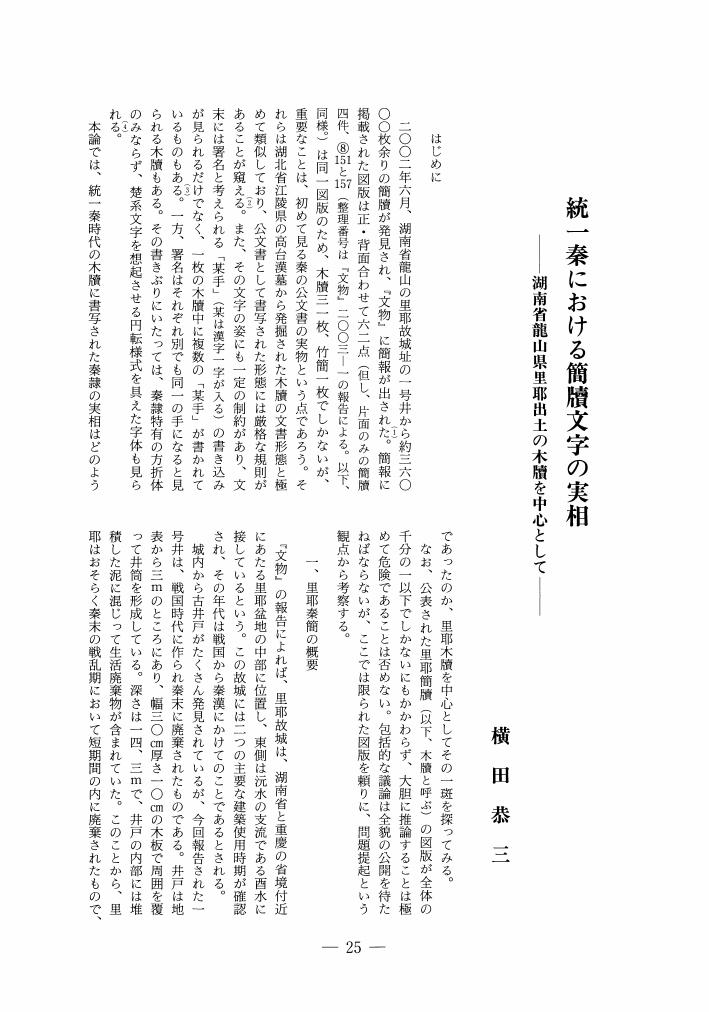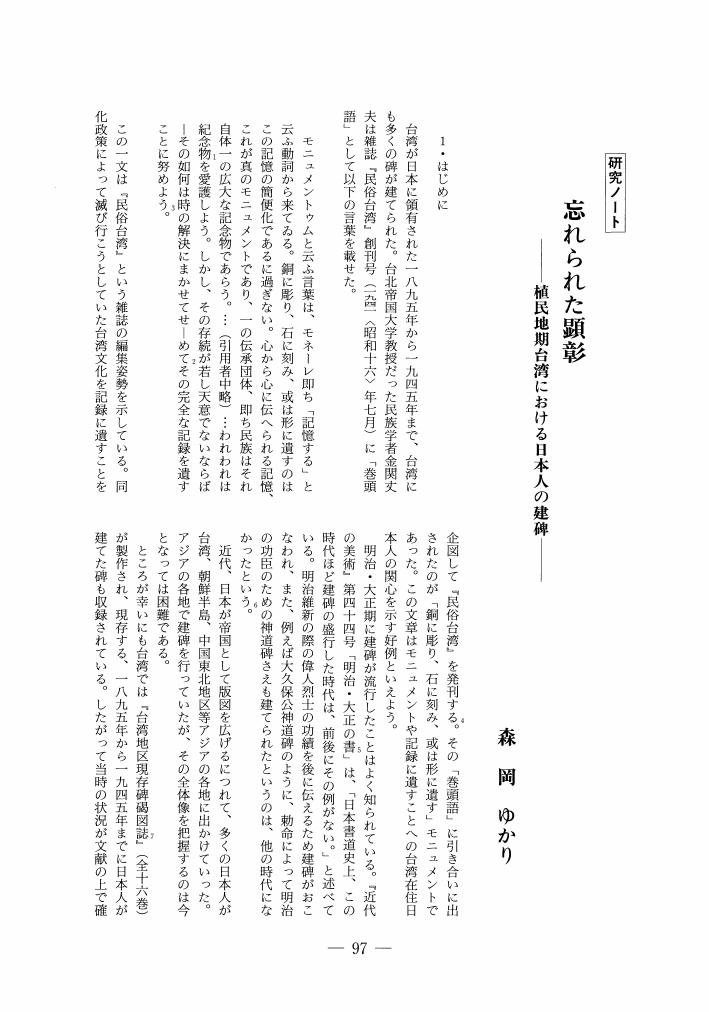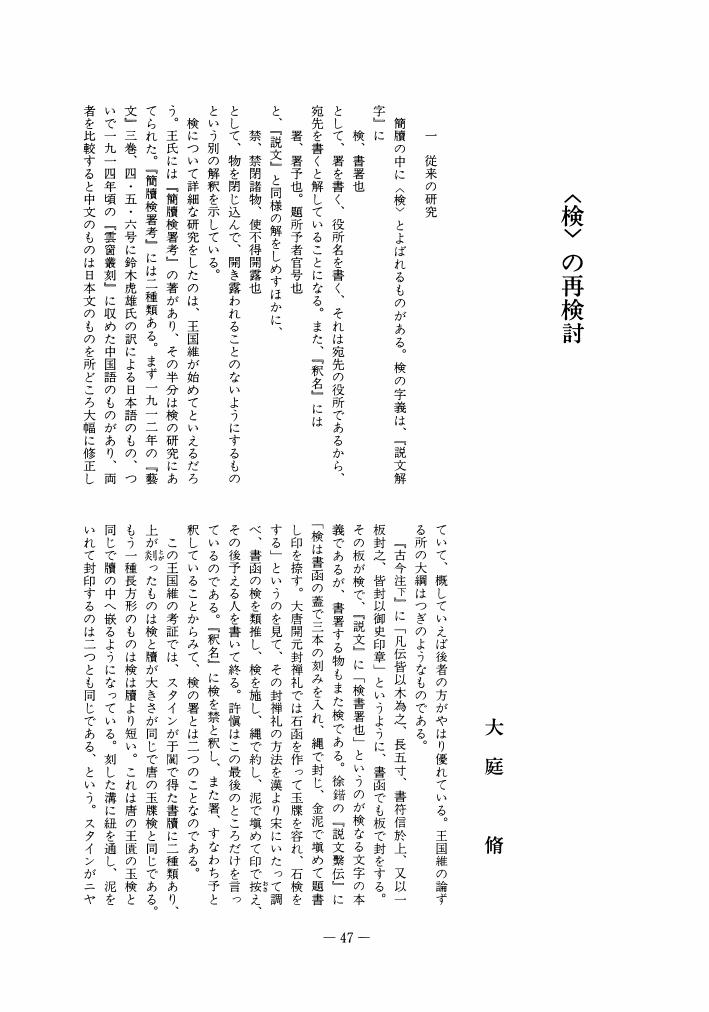33 0 0 0 OA 碑帖拓本資料のデジタル公開における書誌記述の実践
- 著者
- 成田 健太郎
- 出版者
- 書学書道史学会
- 雑誌
- 書学書道史研究 (ISSN:18832784)
- 巻号頁・発行日
- vol.2017, no.27, pp.29-41,85-84, 2017-11-30 (Released:2018-03-23)
In this article, I examine the nature of bibliographic records of calligraphic rubbings based on a grasp of their distinguishing characteristics as source material and give an outline of the preparation of bibliographic records and underlying ideas that I have been putting into practice at the University of Tokyo Library, to which I am affiliated, when making the Libraryʼs calligraphic rubbings publicly accessible. The principal distinguishing characteristic of calligraphic rubbings as source material is the multilayeredness of responsibility. The responsibilities of many people from different periods accrue during the course of creating a calligraphic rubbing, and in research importance must be given to both the individuality and commonalities conferred on the material by these multiple responsibilities. But judging from precedents for bibliographic records of calligraphic rubbings―such as bibliographic records based on the Nippon (Japanese) Cataloging Rules, catalogues of Chinese books, metadata elements used in the main collections of rubbings in Japan, and the “Cataloging Rules for Chinese Rubbings” prescribed by the National Library of China―a form of bibliographic description that takes due account of the multilayeredness of responsibility has not yet been realized. Meanwhile, it is worth noting that in the Functional Requirements for Bibliographic Records endorsed by the International Federation of Library Associations and Institutions it is reported that bibliographic records require functions for recording four attributes, namely, work, expression, manifestation, and item. However, because the locus of responsibility for each attribute cannot be recorded in this model, I have not applied it as it is to calligraphic rubbings and have only referred to its underlying ideas. Taking the above observations into account, in this article I propose metadata elements that are divided into the five strata of work, version, materialization, item, and data and make it possible to record the multilayeredness of responsibility with a certain degree of accuracy.
15 0 0 0 OA 中国芸術における「聖」概念の変容
- 著者
- 松永 恵子
- 出版者
- 書学書道史学会
- 雑誌
- 書学書道史研究 (ISSN:18832784)
- 巻号頁・発行日
- vol.2006, no.16, pp.43-60, 2006-09-30 (Released:2010-02-22)
14 0 0 0 OA 法帖画像アーカイブを研究資源として活用するために
- 著者
- 成田 健太郎 中村 覚 水野 遊大
- 出版者
- 書学書道史学会
- 雑誌
- 書学書道史研究 (ISSN:18832784)
- 巻号頁・発行日
- vol.2020, no.30, pp.71-82,158, 2020-10-31 (Released:2021-03-16)
In recent years, an increasing number of Hojo images have been made public in web data archives. This paper examines a method of, as described below, and its practicability in processing properly a group of archived image data using presently available techniques, thereby enhancing the efficiency of comparative research of Hojos, and thus contributing to the development of research into the history of calligraphy. First, an identifier is given to each of the works listed in Hojos to create source data. The same identifier is given to images of the same work in different materials in order to achieve source control in detecting all the reproduced images of the same work in different materials in a single action. Second, a mechanism is devised to recognize the line breaks in the images, line breaks are given to Hojo images semi-automatically, and an identifier is given to the respective lines. By relating these line identifiers to the above-mentioned work identifiers, it is possible to cut out the image of the target work from the overall image data and display it. Third, an arbitrary string of letters is selected and the mechanism detects images of identical parts among different materials using image-processing technology. This makes it possible to reference different versions of the same work listed in different Hojos without adding text information to the images. Despite the necessity of further technical improvement regarding the referencing of different versions as described in step three, a series of experiments conducted to establish the above-mentioned method suggested the possibility that image processing technology can be developed as a tool to examine more detailed differences found among different lines of Hojos.
6 0 0 0 OA 銭痩鉄と谷崎潤一郎の周辺
- 著者
- 柿木原 くみ
- 出版者
- 書学書道史学会
- 雑誌
- 書学書道史研究 (ISSN:18832784)
- 巻号頁・発行日
- vol.2009, no.19, pp.9-22, 2009 (Released:2012-02-29)
The Chinese seal engraver Qian Shoutie 銭痩鉄 met in Shanghai the Japanese painter Hashimoto Kansetsu 橋本関雪, who invited him to his home in Kyoto, where Qian Shoutie resided for a time, carving seals for Kansetsu and his acquaintances and gaining a good reputation and trust among Japanese men of culture. Around the same time, the popular Japanese author Tanizaki Jun'ichiro 谷崎潤一郎 had asked a friend living in Shanghai to have an address seal and name seal made for him. The engraver commissioned by Tanizaki's friend was Qian Shoutie, and upon receiving the seals, Tanizaki extended his interests to the field of seal engraving. Tanizaki amused himself in the miniature world of seals and came into contact with a great many seal engravers. Donald Keene has written of Tanizaki's works that they should be savoured in their individually published editions rather than in the form of his collected works. This is because Tanizaki's almost obsessive passion was poured into every aspect of the content and binding of his works. In this article, basing myself on the association between the three artists Hashimoto, Qian Shoutie and Tanizaki and the inner depth of this association, I inquire into the engraver of the author's seals on the colophons of first editions of Tanizaki's works, and I also consider the seals used by Tanizaki for his personal use.
5 0 0 0 OA 明治維新における公文書書体の転換
- 著者
- 青山 由起子
- 出版者
- 書学書道史学会
- 雑誌
- 書学書道史研究 (ISSN:18832784)
- 巻号頁・発行日
- vol.2005, no.15, pp.71-87, 2005-09-30 (Released:2010-02-22)
4 0 0 0 OA 「も」の字母に「无」はない
- 著者
- 角 紀子
- 出版者
- 書学書道史学会
- 雑誌
- 書学書道史研究 (ISSN:18832784)
- 巻号頁・発行日
- vol.2001, no.11, pp.83-98, 2001-09-30 (Released:2010-02-22)
- 参考文献数
- 28
4 0 0 0 OA 江戸期における千字文出版情況の考察 ―『割印帳』と『開板御願書扣』を通して―
- 著者
- 史 清晨
- 出版者
- 書学書道史学会
- 雑誌
- 書学書道史研究 (ISSN:18832784)
- 巻号頁・発行日
- vol.2020, no.30, pp.95-110,157, 2020-10-31 (Released:2021-03-16)
The text of Senjimon is said to have a close relevance with calligraphy textbooks. Also, it is one of the important books imported into Japan in ancient times. There are copies of Senjimon that were published during the Muromachi period that were used as prototypes of calligraphy textbooks. During the Edo period, publication of Senjimon expanded on a wave of prosperity in the printing industry. The research results of publication records based on two publication catalogs in the mid-Edo period, Wariincho and Kaihan Onnegai Kakihikae, brought some macroscopic views on the issue. The analytical data based on Wariincho records indicate that the number of Senjimon-related books published in Japan during the Kyoho and Bunka eras totals 108, which represents around 1.41 percent of all the books and around 12.26 percent of all the calligraphy textbooks listed in the catalog. On the other hand, the analytical data based on Kaihan Onnegai Kakihikae record show that the number of Senjimonrelated books published in Osaka, which totals 50, represents around 1.04 percent of all the books and around 16.13 percent of all the calligraphy textbooks listed in the catalog. These Senjimon-related books include various versions of Senjimon other than Shūkei Senjimon. They can be classified by their functions in those intended for calligraphy, reading, both for calligraphy and reading, and calligraphic dictionaries. When the nationalities of the source books are focused upon, the two catalogs show similar results: 24 percent or 22 percent are of Chinese origin, and 76 percent or 78 percent are of Japanese origin. The two catalogs show similarity in terms of the number of Senjimon published, their functions, and the countries of origin of their source books. Although the volume of existing materials on publication is not sufficient enough, results of similar research will show an overview of the publishing situations regarding Senjimon, which can be also utilized as fundamental research on bokujōs of Senjimon itself.
4 0 0 0 OA 書学書道史研究の課題
- 出版者
- 書学書道史学会
- 雑誌
- 書学書道史研究 (ISSN:18832784)
- 巻号頁・発行日
- vol.2020, no.30, pp.123-144, 2020-10-31 (Released:2021-03-16)
4 0 0 0 小曽根乾堂論:―篆刻を中心として―
- 著者
- 神野 雄二
- 出版者
- ASSOCIATION FOR CALLIGRAPHIC STUDIES
- 雑誌
- 書学書道史研究 (ISSN:18832784)
- 巻号頁・発行日
- no.7, pp.85-107, 1997
4 0 0 0 OA 『聾瞽指帰』の再検討
- 著者
- 加藤 詩乃
- 出版者
- 書学書道史学会
- 雑誌
- 書学書道史研究 (ISSN:18832784)
- 巻号頁・発行日
- vol.2014, no.24, pp.15-28,119-118, 2014 (Released:2015-04-11)
The manuscript of the Rōko shiiki 聾瞽指歸 attributed to Kūkai 空海 (Kōbō Daishi 弘法大師) dates from the start of the Heian period. In this article I focus on its formal characteristics and reexamine the advancement of the Japanization of Chinese calligraphic techniques in the history of Japanese calligraphy. The Rōko shiiki is characterized by changes in the size of characters depending on the flow of the narrative and the overall spatial composition and by the use of diverse calligraphic techniques to correlate the characters with surrounding characters. Each of the individual elements has its origin in Chinese calligraphy, but because they have been selected by the calligrapher for the purpose of calligraphic expression and have been structured on the basis of his own interpretation, one can detect an individuality that differs from that of China. In particular, a key to understanding the method of structuring the paper is the "variation and harmony" that are considered to have become established by the time of the Nara period in the history of Japanese calligraphy. Among the Shōsōin 正倉院 documents there are examples in which "variation and harmony" have been employed in the size, placing, and slant of characters. It is to be surmised that the writing styles of immigrant monks and Japanese monks who had studied in China, both groups of whom transmitted the traditional calligraphic style of Wang Xizhi 王羲之, were consulted when developing this sense of composition. In documents of the Nara period, the act of writing by making distinctive use of space and taking into account relationships with nearby characters, based on traditions going back to Wang Xizhi, manifested in a structuring of sheets of paper that displayed "variation and harmony." Consequently, the expression of "variation and harmony" in the Rōko shiiki can be understood as a distinctive feature of "Japanization" that emerged as Chinese calligraphic techniques took root during the Nara period. In the eighth century, when understanding of Chinese calligraphy was inadequate, people were seeking to master calligraphic styles in this manner. As a result, the interpretations and aesthetic sense of people of the Nara period came to be reflected in calligraphy and brought about advancing Japanization in the history of Japanese calligraphy.
3 0 0 0 OA 統一秦における簡牘文字の実相 ―湖南省龍山県里耶出土の木牘を中心として―
- 著者
- 横田 恭三
- 出版者
- 書学書道史学会
- 雑誌
- 書学書道史研究 (ISSN:18832784)
- 巻号頁・発行日
- vol.2004, no.14, pp.25-39, 2004-09-30 (Released:2010-02-22)
3 0 0 0 會津八一と呉昌碩
- 著者
- 角田 勝久
- 出版者
- ASSOCIATION FOR CALLIGRAPHIC STUDIES
- 雑誌
- 書学書道史研究 (ISSN:18832784)
- 巻号頁・発行日
- vol.2012, no.22, pp.95-112, 2012
One of Aizu Yaichi's 會津八一 sobriquets was Konsai 渾齋, which was based on a tablet for which Wu Changshuo 呉昌碩 wrote the calligraphy. In other words, Aizu had a deep interest in Wu Changshuo. In this article, I accordingly examine the relationship between Aizu and Wu Changshuo.<br> When one examines works by Aizu of which the date of composition is known, one finds works from the Taisho era that were produced on the basis of the layout of paintings with poetic inscriptions by Wu Changshuo. Further, some of his postwar poetic inscriptions for paintings consisting of <i>waka</i> 和歌 poems have been executed with innovative ideas by incorporating, for example, the layout of works by Wu Changshuo. When considered in this light, it could be said that from his forties in the Taisho era until his later years after the war Aizu regarded Wu Changshuo's works as an important object of consideration when producing his own works.<br> In June 1949 Aizu had a talk at the head office of the publishing house Chuo Koronsha 中央公論社 with Qian Shoutie 錢痩鐵, a pupil of Wu Changshuo who was visiting Japan at the time. During their talk, Aizu put forward the view that true originality cannot be born from only imitating calligraphers of yore. In the past, calligraphers had spent the greater part of their training in copying the works of past masters. But Aizu flatly rejected this mode of practice to be seen in some calligraphers which was overly focused on imitating people of yore.<br> When one reads this dialogue from 1949 it is evident that Aizu had recognized that originality is not born solely from imitation through the works of Wu Changshuo, who had devoted his life to the copying of the stone-drum inscriptions (<i>shiguwen</i> 石鼓文). In other words, according to Aizu, it was important to assimilate the classics, but at the same time a stance unshackled by them was necessary when composing one's own works. Wu Changshuo was for Aizu an object of consideration not only when producing his own works, but also for establishing his own ideas about the production of works of calligraphy.
2 0 0 0 OA 漢隷の成立
- 著者
- 佐野 光一
- 出版者
- 書学書道史学会
- 雑誌
- 書学書道史研究 (ISSN:18832784)
- 巻号頁・発行日
- vol.2016, no.26, pp.73-100, 2016-10-30 (Released:2017-04-04)
2 0 0 0 OA 日本出土「魏紀年」四鏡の銘文と字体
- 著者
- 福宿 孝夫
- 出版者
- 書学書道史学会
- 雑誌
- 書学書道史研究 (ISSN:18832784)
- 巻号頁・発行日
- vol.1991, no.1, pp.16-29, 1991-06-30 (Released:2010-02-22)
2 0 0 0 OA 忘れられた顕彰 ―植民地期台湾における日本人の建碑―
- 著者
- 森岡 ゆかり
- 出版者
- 書学書道史学会
- 雑誌
- 書学書道史研究 (ISSN:18832784)
- 巻号頁・発行日
- vol.2003, no.13, pp.97-121, 2003-09-30 (Released:2010-02-22)
2 0 0 0 OA 杉村邦彦著『書学論纂』
- 著者
- 尾川 明穂
- 出版者
- 書学書道史学会
- 雑誌
- 書学書道史研究 (ISSN:18832784)
- 巻号頁・発行日
- vol.2019, no.29, pp.101, 2019-10-31 (Released:2020-01-31)
2 0 0 0 OA 寸松庵色紙の伝存点数および改竄の一端
- 著者
- 森岡 隆
- 出版者
- 書学書道史学会
- 雑誌
- 書学書道史研究 (ISSN:18832784)
- 巻号頁・発行日
- vol.2004, no.14, pp.53-72, 2004-09-30 (Released:2010-02-22)
2 0 0 0 篠田家蔵『芥津印譜』とその周辺資料について
- 著者
- 直井 誠
- 出版者
- 書学書道史学会
- 雑誌
- 書学書道史研究 (ISSN:18832784)
- 巻号頁・発行日
- vol.2015, no.25, pp.95-107,176, 2015
Shinoda Kaishin 篠田芥津 (1827–1902) is known as a pioneering adopter of the seal-engraving style of the Chinese Zhe 浙 school in the Edo-Meiji period and also as the teacher of Kawai Senro 河井荃廬. A collection of impressions of seals engraved by Shinoda is the <i>Shinoda Kaishin sensei inpu</i> 篠田芥津先生印譜 (1901), but until now little attention has been paid to the seal impressions it contains or to related works. It is also a fact that there are contradictions and inconsistencies in existing materials regarding Kaishin's career. <br> I was recently provided with unpublished materials, including seal impressions, by Shinoda Katsuharu 篠田捷治, one of Kaishin's descendants (a great-grandson of Kaishin's younger brother Hikobee 彦兵衛), and was apprised of the existence of a private edition of collected seal impressions in four albums titled <i>Kaishin inpu</i> 芥津印譜. This brings together in four albums seals engraved by Kaishin when he was residing in Edo and Gifu, and it was kept by the Shinoda family without being published. These seal impressions provide important material for learning about his engraving style and acquaintances at the time. In addition to the <i>Kaishin inpu</i>, there are also more than two hundred duplicates of seal impressions accompanied by notes in Kaishin's own hand. These are valuable materials that inform us of the dates when these seals were produced and of the extent of his circle of acquaintances. <br> In this article, I organize these materials, identify Kaishin's clients on the basis of the dates and texts of the seals, and determine when he was living in Edo, Gifu, and Kyoto, and by this means I clarify details of his middle years, about which there has been some confusion. This is the main point of this article. Further, in view of the fact that he also carved seals for many men of culture and prominent figures, I was able to confirm the assessment and personality of Kaishin as a seal engraver who was no mere career seal carver.
2 0 0 0 OA 〈検〉の再検討
- 著者
- 大庭 脩
- 出版者
- 書学書道史学会
- 雑誌
- 書学書道史研究 (ISSN:18832784)
- 巻号頁・発行日
- vol.1991, no.1, pp.47-67, 1991-06-30 (Released:2010-02-22)
2 0 0 0 草書の表現法についての考察:―「連綿」を中心に―
- 著者
- 承 春先
- 出版者
- ASSOCIATION FOR CALLIGRAPHIC STUDIES
- 雑誌
- 書学書道史研究 (ISSN:18832784)
- 巻号頁・発行日
- no.11, pp.43-55, 2001









